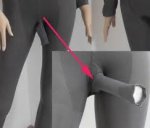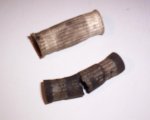Gerry,
I reseal racks/pumps/regulators/CRC's etc., for a living here in the States and feel that I need to set things a bit straight about steering rack repair.
Not so. As long as the power piston is not compromised and the rotating union shaft not grooved from the RU body, the seals can be replaced any number of times. The real problem, these days, is that replacement seals kits available are not made to the exact specifications the factory designated. The Teflon wear strips are a bit thicker and the rubber backing strips are a bit thinner. This is not a good combination. I machine my own seals and do two things.
1) The Teflon wear strips are made exactly to the factory specifications.
2) The backing rings are made 0.005" thicker than the originals out of a very high strength Buna-N rubber (LHM units). This ensures proper 'squeeze' + the backing rings do not take nearly the compression set the ones in the seal kits do.
Again not the whole story. One does needs a socket on a hollow extension to remove the internal control rod from the pinon after the power piston has been removed from the rack body. In addition you need a special extractor for the pin connecting the control rod from the outside end of the power piston unless you want to run the very real risk of screwing that end by using a hammer and drift. Add to that non-marring lockable wrenches to actually take the rack apart. The slide valves in the Cit are all 0.2505" +/- 0.00008" (2 microns). Lapping new valves - you have got to be kidding.
As to setting the cross-over pressures. The best way do to so is on tester prior to putting the unit back in the car. Unless the rack had a problem with center flickering or oscillation prior to being removed from the car, it is really best to just leave that adjustment alone. As I have the proper test set up I check them after a rebuild while on the bench being pressure and leak check. Typically I only have to fool with that adjustment in maybe 10% of the racks I have done. It sounds sexy to some one who does not understand what is being done, but without some experience in doing it you can get into a heap of problem.
LHS racks are the ones quite prone to internal corrosion. LHM racks, so long as they have been protected from the elements, are almost invariably good to prefect inside. If the power piston cylinder is corroded one is not going to sleeve and rebore/grind. For the cost of that one could buy a new rack. Typically all power piston cylinder needs is cleaning with a circular brass wire brush so the walls are smooth. Not sure what your Indian friend's problem was. The sliding/rotating seals in the entire unit are Teflon, the backing rings are either Buna-N or EDPM rubber (depending on fluid) as are the 4 0-rings. The two anti- extrusion seals in the power piston are Nylon as are the two center spacers for the power piston.
But to the real problem. There are a some special mandrels one needs to either get the seals in position or after they are in position getting the parts together. If you don't have these tools, about 3 out of 4 times (maybe 2 out of 3) you will rip the Teflon wear strips apart or worse create a crease in the surface that will cause the rack to start leaking soon after it has been assembled and put into service.
As to the older and later racks. There are two differences. Earlier racks (pre 7/67) used a 21mm diameter power piston. Later racks use a 19mm power piston. Prior to 1965 the RU had 5 0-rings in it - after 1965 there are 4 Teflon wear strips for the HP ports and 1 0-ring that seals off the return port. Actual internal dimensions for both power piston end and RU remained the same. The reason the factory decreased the size of the piston is that by doing so it increased the amount of force available to assist in steering. All they had to change from a sealing standpoint was to change the OD/ID of the Teflon seals and the backing rings. If one does not have the facilities to make them, Western Hemispheres in Watsonville, CA carries seals for both types of racks - Miles gets them from the usual suspects in Europe.
Prior to 1963 things get a bit more complicate as the factory had 2 major revisions to the power piston assembly in 5/58 and 12/63.
Steve
I reseal racks/pumps/regulators/CRC's etc., for a living here in the States and feel that I need to set things a bit straight about steering rack repair.
gerry freed said:You can recon the rack yourself, I have done several BUT by now most have them have be reconed once and perhaps twice and are not easy to do again because it is no longer a simple case of changing seals.
Not so. As long as the power piston is not compromised and the rotating union shaft not grooved from the RU body, the seals can be replaced any number of times. The real problem, these days, is that replacement seals kits available are not made to the exact specifications the factory designated. The Teflon wear strips are a bit thicker and the rubber backing strips are a bit thinner. This is not a good combination. I machine my own seals and do two things.
1) The Teflon wear strips are made exactly to the factory specifications.
2) The backing rings are made 0.005" thicker than the originals out of a very high strength Buna-N rubber (LHM units). This ensures proper 'squeeze' + the backing rings do not take nearly the compression set the ones in the seal kits do.
gerry freed said:There is only one special mechanical tool needed, to undo the nut on the piston. I made one up. You will need a fitting and gauges to set up and test the cross over pressures. Again I made one and it is probably still in the NSW Club tool stock. If the valves are worn, lapping in new pistons is not for the faint hearted and best to get a recon unit. My preferred source for these and rebuilt racks is Citrogaz but with the postal charges these days it is not a cheap way to go. http://www.citrogaz.com/
Again not the whole story. One does needs a socket on a hollow extension to remove the internal control rod from the pinon after the power piston has been removed from the rack body. In addition you need a special extractor for the pin connecting the control rod from the outside end of the power piston unless you want to run the very real risk of screwing that end by using a hammer and drift. Add to that non-marring lockable wrenches to actually take the rack apart. The slide valves in the Cit are all 0.2505" +/- 0.00008" (2 microns). Lapping new valves - you have got to be kidding.
As to setting the cross-over pressures. The best way do to so is on tester prior to putting the unit back in the car. Unless the rack had a problem with center flickering or oscillation prior to being removed from the car, it is really best to just leave that adjustment alone. As I have the proper test set up I check them after a rebuild while on the bench being pressure and leak check. Typically I only have to fool with that adjustment in maybe 10% of the racks I have done. It sounds sexy to some one who does not understand what is being done, but without some experience in doing it you can get into a heap of problem.
gerry freed said:Once in the rack, if it has been left standing and unused for a long period you may well find that the centre of the cylinder is badly pitted. Also the piston could have corroded. If either is the case you are facing some precision engineering to resleeve the cylinder or rechrome the piston and I would consider it a throw away item. If the cylinder is perfect, requiring a little or no honing then your next challenge is to get a set of seals. My Indian friends made up several sets but had a lot of difficulty identifying the materials to copy them. They don't come straight out of a hydraulics parts catalogue. Again Michel at Citrogaz can advise on current supplies.
Note that there are two diameters of cylinder, the early ones were smaller and the parts as rare as hen's teeth.
LHS racks are the ones quite prone to internal corrosion. LHM racks, so long as they have been protected from the elements, are almost invariably good to prefect inside. If the power piston cylinder is corroded one is not going to sleeve and rebore/grind. For the cost of that one could buy a new rack. Typically all power piston cylinder needs is cleaning with a circular brass wire brush so the walls are smooth. Not sure what your Indian friend's problem was. The sliding/rotating seals in the entire unit are Teflon, the backing rings are either Buna-N or EDPM rubber (depending on fluid) as are the 4 0-rings. The two anti- extrusion seals in the power piston are Nylon as are the two center spacers for the power piston.
But to the real problem. There are a some special mandrels one needs to either get the seals in position or after they are in position getting the parts together. If you don't have these tools, about 3 out of 4 times (maybe 2 out of 3) you will rip the Teflon wear strips apart or worse create a crease in the surface that will cause the rack to start leaking soon after it has been assembled and put into service.
As to the older and later racks. There are two differences. Earlier racks (pre 7/67) used a 21mm diameter power piston. Later racks use a 19mm power piston. Prior to 1965 the RU had 5 0-rings in it - after 1965 there are 4 Teflon wear strips for the HP ports and 1 0-ring that seals off the return port. Actual internal dimensions for both power piston end and RU remained the same. The reason the factory decreased the size of the piston is that by doing so it increased the amount of force available to assist in steering. All they had to change from a sealing standpoint was to change the OD/ID of the Teflon seals and the backing rings. If one does not have the facilities to make them, Western Hemispheres in Watsonville, CA carries seals for both types of racks - Miles gets them from the usual suspects in Europe.
Prior to 1963 things get a bit more complicate as the factory had 2 major revisions to the power piston assembly in 5/58 and 12/63.
Steve
Last edited:


